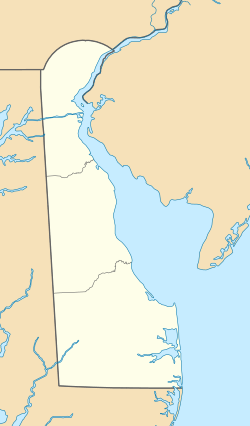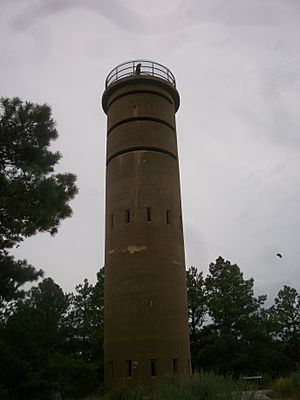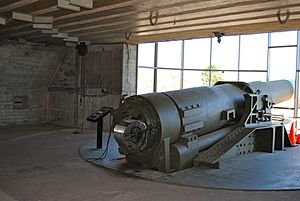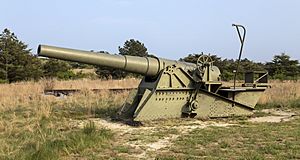Fort Miles facts for kids
Quick facts for kids Fort Miles |
|
|---|---|
| Part of Harbor Defenses of the Delaware | |
| Sussex County, Delaware | |
| Type | Fortification |
| Site information | |
| Owner | Public - State of Delaware |
| Controlled by | Cape Henlopen State Park |
| Open to the public |
Yes |
| Site history | |
| Built | 1940–1942 |
| Built by | U.S. Army Corps of Engineers |
| In use | 1942–1991 |
| Materials | Reinforced concrete, earth |
| Battles/wars | World War II |
| Garrison information | |
| Garrison |
|
|
Fort Miles Historic District
|
|
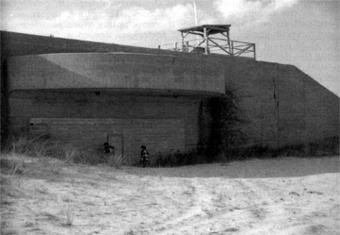
Battery 519 at Fort Miles, Circa 1973
|
|
| Location | Cape Henlopen State Park, Sussex County, Delaware, USA |
| Nearest city | Lewes, Delaware |
| Built | 1940 |
| NRHP reference No. | 04001076 |
| Added to NRHP | September 30, 2004 |
Fort Miles was a military base built by the United States Army during World War II. It is located on Cape Henlopen near Lewes, Delaware. Even though money was approved in 1934, building the fort didn't start until 1938. On June 3, 1941, it was named after Lieutenant General Nelson A. Miles.
This fort was the main defense for the Harbor Defenses of the Delaware. Its job was to protect Delaware Bay and the Delaware River. It also kept ships safe from enemy attacks between Cape May and Cape Henlopen. This was especially important to stop German ships.
Fort Miles also had a secret underwater minefield. This minefield stopped enemy ships from entering the Delaware River. In 2016, after Hurricane Hermine, one of these old sea mines was found. Park staff helped to carefully preserve it.
By 1950, the Army's job of defending the coast changed. The Navy took over, and old coastal guns were no longer needed. So, Fort Miles became extra land. The Army still used parts of it. In 1962, the Navy opened Naval Facility (NAVFAC) Lewes there. This was a listening station called Sound Surveillance System. It replaced a damaged station in New Jersey. NAVFAC Lewes operated from 1962 to 1981. Today, the main building is the Biden Environmental Conference Center. Fort Miles is now part of Cape Henlopen State Park.
Contents
Fort Miles in World War II
Before World War II, the main defense for the Delaware area was Fort Saulsbury. This fort had four large 12-inch (305 mm) guns. However, it did not have smaller guns to help. As gun technology improved, defenses moved closer to the sea.
When war started in Europe in 1939, the U.S. began planning its defenses faster. In 1940, the Army decided to build 38 large gun batteries along the U.S. coast. These batteries would have 16-inch (406 mm) guns and be protected from air attacks. Two of these were planned for Fort Miles. Construction on the first one, Battery 118, started in March 1941. It was later named Battery Smith.
The first guns ready at the fort were four mobile 155 mm (6.1 in) guns. These arrived in April 1941. Concrete bases for these guns were finished by June 1942. Soldiers from the Delaware Army National Guard arrived in June 1941.
The attack on Pearl Harbor made construction at Fort Miles speed up. The U.S. declared war, and soldiers stayed at the fort. In early 1942, 14 ships were sunk off the New Jersey coast. This included a U.S. Navy destroyer. Many more guns were added to Fort Miles. A large minefield was also placed in the waters near Lewes.
Even with all these defenses, Fort Miles never saw real combat. Its guns were fired many times for practice. In May 1945, something important happened. A German U-boat (submarine), U-858, surrendered to the soldiers at Fort Miles. This was the first enemy ship to surrender to U.S. forces after Germany's defeat in World War II.
In March 1942, four 8-inch (203 mm) railway guns arrived. These guns were on train cars. By September, four more joined them. These railway guns could move to different locations. Another early battery was Battery 5, with four 3-inch (76 mm) guns. These guns were ready by August 1942.
Battery 118 (Smith) was finished in October 1942. Its 16-inch (406 mm) guns were mounted in December 1942. Another 16-inch (406 mm) gun battery, Battery 119, was planned but canceled. Instead, Battery 519 was built. It had two 12-inch (305 mm) guns moved from another fort. Construction on Battery 519 started in November 1942 and finished in August 1943.
Batteries 221 (Herring) and 222 (Hunter) were finished in 1943. Each had two 6-inch (152 mm) guns. These guns were on high mounts and had bunkers for ammunition.
Two Anti-Motor Torpedo Boat (AMTB) batteries were also at Fort Miles. These were AMTB 5A and AMTB 5B. They had 90 mm (3.5 in) guns that could shoot at both ships and airplanes. Each battery had fixed and mobile 90 mm (3.5 in) guns. They also had 40 mm (1.6 in) Bofors guns. Both were finished in June 1943.
Fort Miles also had help from three batteries in New Jersey. These included 155 mm (6.1 in), 6-inch (152 mm), and 90 mm (3.5 in) gun batteries.
At its busiest, Fort Miles had over 2,200 soldiers. This included both men and women. They were from different military units. Fort Miles never saw major fighting. Its guns were used for practice, but never against an enemy. A 16-inch (406 mm) gun was fired only once for testing. The powerful recoil damaged the gun's spot, so it was not fired again.
Tall concrete towers, called fire control towers, were built along the coast. These towers were used to find the exact location of enemy ships or submarines. Five of these towers are still standing in Cape Henlopen State Park. One of them, Tower 7, can be visited by the public. Many bunkers were also built to hold guns and other weapons. Barracks, offices, and a pier were also part of the fort.
By March 1944, the threat from enemy ships was much lower. So, Fort Miles began to reduce its forces. Many soldiers were moved to other units or bases. By April 1945, the main unit at Fort Miles was no longer active.
Fort Miles Weaponry
The four largest gun batteries at Fort Miles were Battery 118 (Battery Smith), Battery 221 (Battery Herring), Battery 222 (Battery Hunter), and Battery 519. Battery 519 was never officially named. It was only known by its construction number.
| Number | Name | Completed | Disarmed | Abandoned | Armament | Range (yards) |
|---|---|---|---|---|---|---|
| 5 (Exam) | 31 August 1942 | 1946 | four M1903 3-inch (76 mm) guns on pedestal mounts | 11,300 yd (10,300 m) | ||
| 5A | 15 June 1943 | 1946 | four (two fixed and two mobile) 90 mm (3.5 in) guns and 2 mobile 40 mm (1.6 in) guns | 19,500 yd (17,800 m) | ||
| 5B | 15 June 1943 | 1946 | four (two fixed and two mobile) 90 mm (3.5 in) guns and 2 mobile 40 mm (1.6 in) guns | 19,500 yd (17,800 m) | ||
| 20 | Rail A | December 1942 | 5 April 1944 | four MK VI M3A2 8-inch (203 mm) guns mounted on M1A1 Railway Carriages | 35,300 yd (32,300 m) | |
| 21 | Rail B | June 1942 | 5 April 1944 | four MK VI M3A2 8-inch (203 mm) guns mounted on M1A1 Railway Carriages | 35,300 yd (32,300 m) | |
| 22 | 15 June 1942 | February 1944 | "upon completion of permanent batteries" | four 155 mm (6.1 in) M1918M1 guns on Panama mounts | 19,100 yd (17,500 m) | |
| 118 | Smith | 31 October 1942 | 1948 | 1958 | two MK II MI Navy 16-inch (406 mm) guns, mounted on Army M4 barbette carriages | 45,150 yd (41,290 m) |
| 221 | Herring | 31 August 1943 | 1948 | 1958 | two M1903A2 6-inch (152 mm) guns on shielded barbette carriages | 27,100 yd (24,800 m) |
| 222 | Hunter | 29 October 1943 | 1947 | 1958 | two M1903A2 6-inch (152 mm) guns on shielded barbette carriages | 27,100 yd (24,800 m) |
| 519 | 31 August 1943 | 1948 | 1958 | two M1895 M1A2 12-inch (305 mm) guns on M1917 barbette carriages | 29,300 yd (26,800 m) |
Fort Miles During the Cold War
Most of Fort Miles was no longer needed by 1949. However, the Army continued to use parts of it. It became a recreation area for military families until the early 1990s. In 1964, 543 acres of federal land were given to Delaware. This land became Cape Henlopen State Park. More land was given to the park over time.
Fort Miles stopped being a military base in 1991. This was part of a process to close military bases. The remaining 96 acres of Fort Miles were given to Delaware. They were to be used only for public parks or recreation. The last official use of the fort was for soldiers returning from the first Gulf War.
In 1962, the United States Navy took over a part of Fort Miles. This included Batteries Smith and Herring. They set up Naval Facility Lewes (NAVFAC Lewes). This was a secret listening station called Sound Surveillance System. It replaced a station in New Jersey that was damaged in a storm. The equipment was moved to Fort Miles by a Navy ship.
NAVFAC Lewes operated until September 30, 1981. The SOSUS program was secret until 1991. So, what NAVFAC Lewes did was kept secret for a long time. The main building later became a Naval Reserve Center. All the land was returned to the state in 1996. That building is now the Biden Environmental Conference Center. Some housing for military families became facilities for the University of Delaware.
Fort Miles Today
Battery Smith once held two large 16-inch (406 mm) guns. Today, Cape Henlopen State Park uses it for storage. A 16-inch (406 mm) gun from the battleship USS Missouri (BB-63) has been placed at Fort Miles as a display. Parts of the wreckage from USS Arizona (BB-39) are also planned to be added.
Battery Herring was once covered with sand. It was dug out and used for NAVFAC Lewes. That structure is now gone. The old administration building is now a conference center. Battery Hunter is now used as a Hawk Watch station.
Battery 519 originally had two 12-inch (305 mm) guns. It is now being renovated to become a museum. This museum will celebrate Delaware's role in World War II. Tours began in 2004. It has a restored 12-inch (305 mm) gun, just like the original. The museum also has a German 20 mm (0.79 in) anti-aircraft cannon. This cannon was captured from the U-858 submarine after it surrendered. An old 8-inch (203 mm) railway gun, changed into a 9.12-inch (232 mm) test weapon, is also on display. Four concrete bases for 155 mm (6.1 in) guns still exist at Battery 22. They are near the Beach House in the park.
You can take walking tours of the bunkers and other areas being restored during the summer. The Delaware Department of Natural Resources and Environmental Control (DNREC) manages this project. You might see historic interpreters at the park during special events. These events show what military life was like at Fort Miles. Reenactors act out the roles of soldiers from the 261st Coast Artillery Battalion. Several fire control towers are still at Fort Miles. At least one of them is open to the public.


